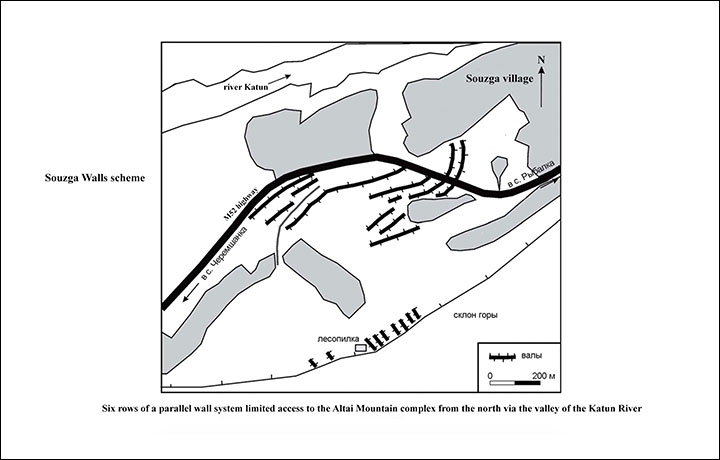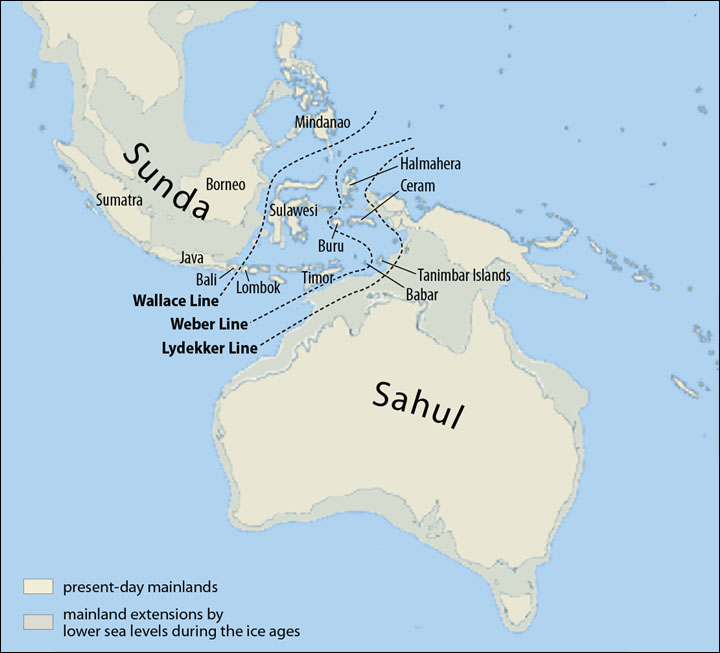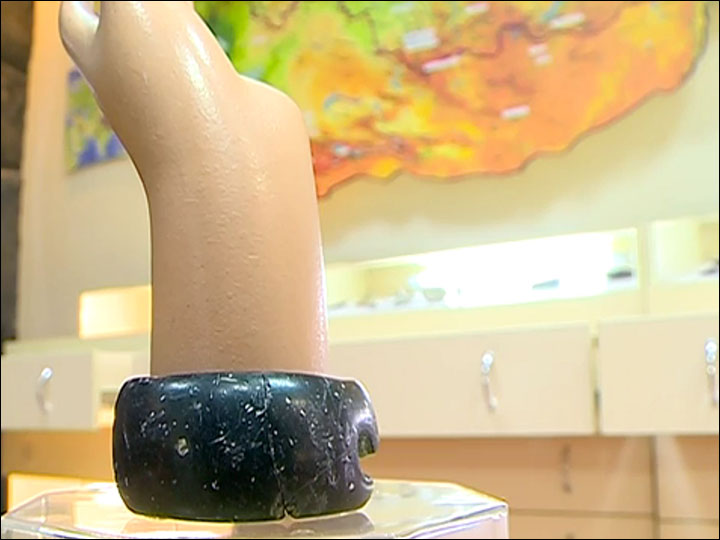warriors of the steppe in movies, music and art
Aug 23, 2017 0:24:40 GMT -5
Post by Deleted on Aug 23, 2017 0:24:40 GMT -5
The Great Wall of Siberia?
Link:
siberiantimes.com/science/casestudy/features/discovered-the-great-wall-of-siberia-dating-to-1st-millennium-bc/
According to archeologist Professor Andrey Borodovsky giant ramparts guarded Altai Mountains against attack from the north dated to the 1st millennium BC.
I could imagine Robert E. Howard writing a great yarn about the oncoming onslaught of the north-eastern Siberian Altaic tribes and the fierce resistance of the wandering adventurous Indo-European warriors.

Discovered: the Great Wall of Siberia. Picture: Andrey Borodovsky
The wall complex - now almost hidden to the naked eye - is believed to date from a long era that also saw such constructions as the Great Wall of China and Hadrian's Wall.
Concealed under thick layers of turf are huge stones put in place by ancient man, says the scientist.
Six rows of a parallel wall system limited access to the Altai Mountain complex from the north via the valley of the Katun River.
It is not known who built the giant ramparts.
Their width is a substantial ten metres with an impressive height of up to eight metres.
'To the east of these walls is a fairly wide passage, which is limited at the mountainside by another series of walls, oriented west-east across the Katun valley,' he said.
There are nine walls adjacent to the mountain slope.
Professor Andrey Borodovsky said: 'These walls were clearly made to cut off crowds of people, and make them go through a narrow passage in the direction chosen by the creators of the (construction).'
In this way access from the steppes to the mountains - the home of ancient civilisations, for example of the Pazyryk people - could be controlled.
Some of the walls were destroyed by the construction of the Chuya highway in tsarist times, modernised by Stalin using prisoner labour.
The western section of the ramparts were substantially lost when the modern-day village Souzga was widened.
'It is not easy to photograph the walls so that they are visible,' Andrey Borodovsky said. Nor do satellite images help much.
Yet Prof Borodovsky insists geophysical analysis using scans shows the structures here were manmade not natural.
He has announced plans to conduct detailed research here next year which - while not long in total length, with more than 1 kilometre identified - are high in historical significance.
So far archeological evidence of man from the areas around the walls points to a medieval presence yet the researcher from the
Institute of Archaeology and Ethnography in Novosibirsk is convinced proof will be found of their construction much earlier.
'Geophysics has clearly confirmed that the Souzga walls were artificially created,' he told The Siberian Times.
'It is not very easy to determine the age of such constructions, when exactly were they created, but I believe it was around the first millennium BC - the beginning of new era.
'That is Iron Age or even Bronze Age, but more likely - Iron Age.
'I'm basing this on the fact that it was the time when such constructions are created all over the world, for example the famous Hadrian's Wall also fits into this trend. The problem is that the only archeological finds around these walls, as of now, are dated as medieval.
'But I still believe that in Middle Ages there was not a big enough community here which could afford to build such a formidable construction.
'Besides, there also was no need for such a construction because in Middle Ages there were a lot of small, scattered communities here.'
Andrey Borodovsky said: 'All the impressive defensive lines in Eurasia were built in the period from the beginning of the first millennium BC up to the opening half of the first millennium AD.
'This is the era of late Bronze Age and early Iron Age, including the Hunnish time on the eve of the Great Migration of Nations.
'Such a fortification process was due to a number of factors.
'First, the appearance of significant human resources in this era, thanks to the potential of an integrated manufacturing economy.
'Secondly, the aggravation of military conflicts and a significant increase in their scale.
'Thirdly, the formation of large state and proto-state entities, which had economic, cultural and political boundaries and these boundaries ... to separate their world from aliens.
'We remember the Great Wall of China, which was formed over several centuries and basically built by the third century BC, and Hadrian's Wall in Britain, at the decline of the late Roman Empire.
'In the same series of mammoth defensive structures is the Serpent's Wall [an ancient system of earthen fortifications stretch across Ukraine, from the town of Zmiiv in the east to Podolia in the west], the beginning of the erection of which dates back to the late Bronze Age.'
Words by Anna Liesowska.
Link:
siberiantimes.com/science/casestudy/features/discovered-the-great-wall-of-siberia-dating-to-1st-millennium-bc/
According to archeologist Professor Andrey Borodovsky giant ramparts guarded Altai Mountains against attack from the north dated to the 1st millennium BC.
I could imagine Robert E. Howard writing a great yarn about the oncoming onslaught of the north-eastern Siberian Altaic tribes and the fierce resistance of the wandering adventurous Indo-European warriors.

Discovered: the Great Wall of Siberia. Picture: Andrey Borodovsky
The wall complex - now almost hidden to the naked eye - is believed to date from a long era that also saw such constructions as the Great Wall of China and Hadrian's Wall.
Concealed under thick layers of turf are huge stones put in place by ancient man, says the scientist.
Six rows of a parallel wall system limited access to the Altai Mountain complex from the north via the valley of the Katun River.
It is not known who built the giant ramparts.
Their width is a substantial ten metres with an impressive height of up to eight metres.
'To the east of these walls is a fairly wide passage, which is limited at the mountainside by another series of walls, oriented west-east across the Katun valley,' he said.
There are nine walls adjacent to the mountain slope.
Professor Andrey Borodovsky said: 'These walls were clearly made to cut off crowds of people, and make them go through a narrow passage in the direction chosen by the creators of the (construction).'
In this way access from the steppes to the mountains - the home of ancient civilisations, for example of the Pazyryk people - could be controlled.
Some of the walls were destroyed by the construction of the Chuya highway in tsarist times, modernised by Stalin using prisoner labour.
The western section of the ramparts were substantially lost when the modern-day village Souzga was widened.
'It is not easy to photograph the walls so that they are visible,' Andrey Borodovsky said. Nor do satellite images help much.
Yet Prof Borodovsky insists geophysical analysis using scans shows the structures here were manmade not natural.
He has announced plans to conduct detailed research here next year which - while not long in total length, with more than 1 kilometre identified - are high in historical significance.
So far archeological evidence of man from the areas around the walls points to a medieval presence yet the researcher from the
Institute of Archaeology and Ethnography in Novosibirsk is convinced proof will be found of their construction much earlier.
'Geophysics has clearly confirmed that the Souzga walls were artificially created,' he told The Siberian Times.
'It is not very easy to determine the age of such constructions, when exactly were they created, but I believe it was around the first millennium BC - the beginning of new era.
'That is Iron Age or even Bronze Age, but more likely - Iron Age.
'I'm basing this on the fact that it was the time when such constructions are created all over the world, for example the famous Hadrian's Wall also fits into this trend. The problem is that the only archeological finds around these walls, as of now, are dated as medieval.
'But I still believe that in Middle Ages there was not a big enough community here which could afford to build such a formidable construction.
'Besides, there also was no need for such a construction because in Middle Ages there were a lot of small, scattered communities here.'
Andrey Borodovsky said: 'All the impressive defensive lines in Eurasia were built in the period from the beginning of the first millennium BC up to the opening half of the first millennium AD.
'This is the era of late Bronze Age and early Iron Age, including the Hunnish time on the eve of the Great Migration of Nations.
'Such a fortification process was due to a number of factors.
'First, the appearance of significant human resources in this era, thanks to the potential of an integrated manufacturing economy.
'Secondly, the aggravation of military conflicts and a significant increase in their scale.
'Thirdly, the formation of large state and proto-state entities, which had economic, cultural and political boundaries and these boundaries ... to separate their world from aliens.
'We remember the Great Wall of China, which was formed over several centuries and basically built by the third century BC, and Hadrian's Wall in Britain, at the decline of the late Roman Empire.
'In the same series of mammoth defensive structures is the Serpent's Wall [an ancient system of earthen fortifications stretch across Ukraine, from the town of Zmiiv in the east to Podolia in the west], the beginning of the erection of which dates back to the late Bronze Age.'
Words by Anna Liesowska.







